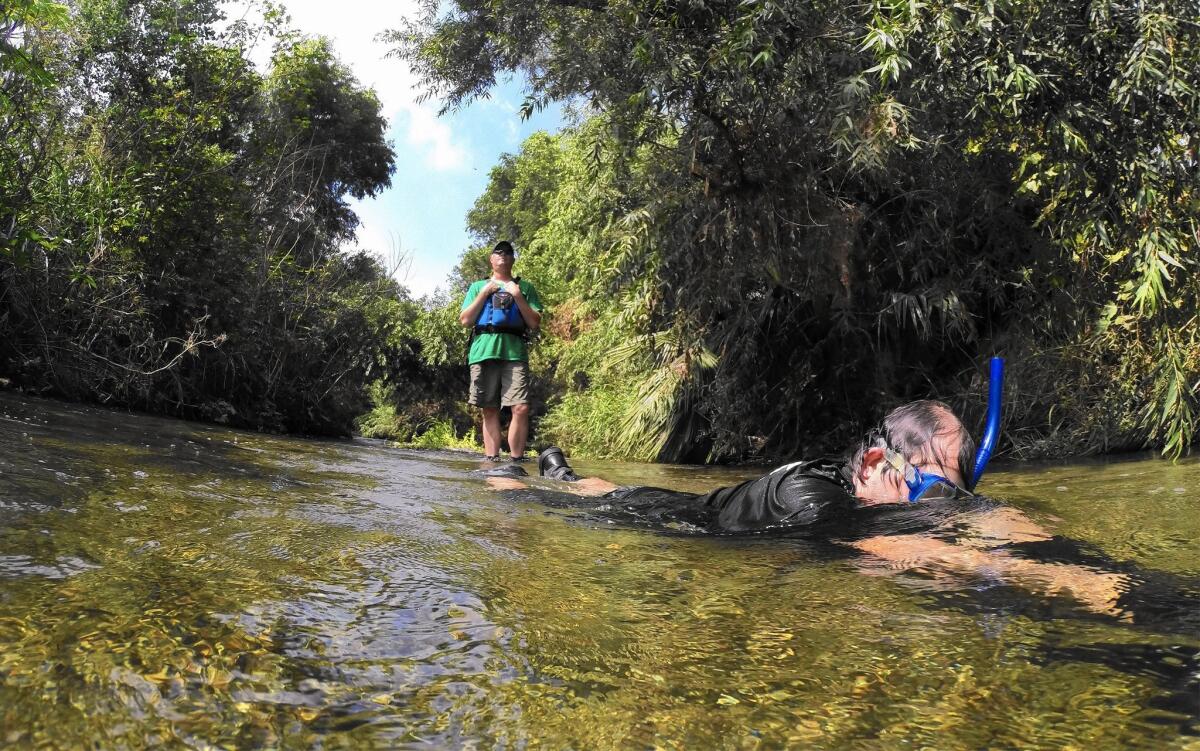Struggle to save endangered Santa Ana sucker may reach U.S. Supreme Court

A 20-year struggle to protect a rare bottom-feeding fish from extinction appears headed toward resolution as Inland Empire cities and water agencies are asking the court of last resort to intervene.
Two cities and 10 water agencies say they will petition the U.S. Supreme Court to halt a plan to try to save the Santa Ana sucker that involves designating critical habitat that could restrict water uses on the Santa Ana River.
The governments argue that the U.S. Fish and Wildlife Serviceâs plan, upheld last month by the 9th Circuit Court of Appeals, unfairly imposes restrictions on water conservation, groundwater recharge and flood control operations that affect more than 1 million Southern California residents.
Of particular concern are northern reaches of the drought-stricken 96-mile-long Santa Ana River watershed, which environmentalists contend must be protected so that seasonal ebbs and flows â and flood events â can move gravel to downstream spawning grounds.
Opponents argue that some areas designated as critical habitat are dry most of the year and therefore of no help in fulfilling the suckerâs complex life cycle. The designation, they say, also limits the agenciesâ ability to recharge groundwater aquifers with captured runoff from rainstorms in those areas.
Federal officials contend that the concerns of opponents are exaggerated. The designation of more than 9,000 acres of land as critical habitat requires federal agencies such as the U.S. Army Corps of Engineers to consult with the Fish and Wildlife Service before they carry out, fund or authorize any local action that could destroy or alter the habitatâs functionality.
The dispute has grown more intense in recent years as dry conditions have depleted the amount of water in the river.
âRight now, there are no clear rules of the road when the interests of a species and habitat intersect with the interests of the human environment,â said Greg Wilkinson, a lawyer representing the water agencies.
------------
FOR THE RECORD
An earlier version of this article misspelled attorney Greg Wilkinsonâs name as Wilkenson.
------------
This week, U.S. Geological Survey scientists launched the most comprehensive survey ever of the Santa Ana sucker and other native fish populations and habitat. The effort began along a three-mile stretch of mostly treated urban runoff between the cities of Colton and Riverside, where scientists in snorkeling gear counted fish while others measured surface flows and movements of sand and gravel.
The suckers were once abundant across Southern California. They have mottled gray backs and silver bellies, grow to about 5 inches in length and have large, thick lips and small mouths to vacuum up algae and other organisms.
Today they are found in the headwaters of San Gabriel River in the Angeles National Forest, Big Tujunga Creek in the Los Angeles River Basin, portions of the Santa Ana River and parts of the Santa Clara River system in Los Angeles and Ventura counties.
Since being listed as a threatened species in 2000, its numbers have continued to decline because of water diversions, dams, erosion, debris, pollution, heavy recreational use of waterways, extreme alterations of stream channels, and nonnative species that prey on suckers and compete for habitat.
Douglas Headrick, general manager of the San Bernardino Valley Municipal Water District and a spokesman for the coalition, said all parties agree that âthe Santa Ana sucker is not doing well and needs help. But we believe that we can develop sustainable viable habitat for the species without wasting hundreds of millions of dollarsâ worth of water to move gravel for the sucker.â
Headrick said the federal plan would use valuable water âas an untested mechanism to move gravel downstream at some future date. That does not seem like a good decision for the people of Southern California.â
John Buse, an attorney with the Center for Biological Diversity, said the plan does not threaten any water supplies. âItâs simply a blueprint of what is needed to ensure the suckersâ existence,â he said.
An independent analysis conducted for the Fish and Wildlife Service shows that the potential cost of ensuring that future residential, commercial, water and transportation projects would not adversely modify or destroy designated critical habitat could range from about $14 million to $450 million over 20 years.
The water agencies sued Fish and Wildlife in 2011 arguing that its designation of critical habitat in rivers, creeks and washes in San Bernardino and Riverside counties was done without their collaborative input as required under the National Environmental Policy Act.
Environmental groups led by the Center for Biological Diversity, CalTrout, the Sierra Club and the Audubon Society responded by filing petitions to intervene in the case on behalf of the Fish and Wildlife Service. Buse described the agenciesâ decision to petition the Supreme Court as âan extreme long shot.â
The drought has complicated ongoing efforts to restore habitat along the Santa Ana River. Groundwater levels have fallen so low that an estimated 25% of the river appears to be percolating into the groundwater basin, rather than flowing downstream.
Less surface water âis a big problem,â said Heather Dyer, a biologist with the Valley District, âwhen youâre worried about balancing the needs of the region and a threatened species.â
Twitter: @LouisSahagun
NEWSLETTER: Get essential California headlines delivered daily >>
ALSO:
Mexico is cracking down on U.S. boaters who venture into its waters
San Pedro Fish Market hopes for smooth sailing in waterfront revamp
Irvine neighborhood uses education to remove welcome mat for coyotes
More to Read
Get the Latinx Files newsletter
Stories that capture the multitudes within the American Latinx community.
You may occasionally receive promotional content from the Los Angeles Times.







